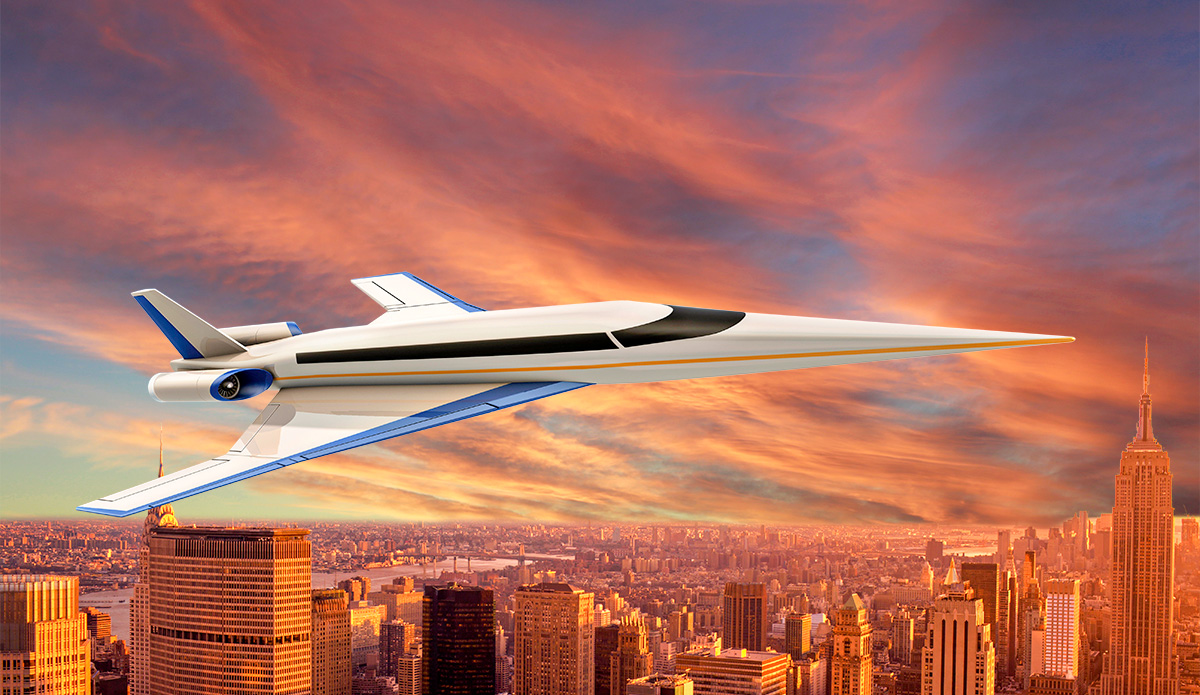
The dream of flying: Is this the future of aviation?
In the wake of the pandemic, the question of what contemporary travel that emphasizes sustainability and luxury might look like is increasingly being asked.
December 15, 2022
Take off in style
Sweats, comfortable shoes and travel pillow handy: That's what most passengers look like on long-haul flights today, no matter what class they're traveling in. But there was also a time when flying was a chic party in the air, especially if you had the privilege of traveling in the "Queen of the Skies," as the Concorde was once called. The super-rich used the plane to travel the nearly 6,000 kilometers from Paris to New York in a fabulous three and a half hours at supersonic speed, and in the greatest possible style. "It was like a kind of last gasp of the golden era of travel. You always dressed better than usual for it because you never knew who you were going to run into," recalls supermodel Cindy Crawford.
For a long time, flight attendants resembled hotels staff - since then, a lot has changed in terms of fashion. © Photo: From the book "Supersonic"/Prestel Verlag/courtesy the Adrian Meredith Concorde Collection.
Status symbol and myth
The Concorde was always more than just a means of transport: it was a status symbol and a myth, a kind of entry ticket to the jet set lifestyle. On November 22, 1977, the first Concorde departed from Paris for New York: Lobster medallions were served as an appetizer, star chef Alain Ducasse had put together the menu, champagne was flowing in streams, caviar was served. Paul McCartney is said to have spontaneously performed a few Beatles songs during a flight, Andy Warhol raved about the silverware and called for it have it packed up. "For 27 years, from 1976 to 2003, the Concorde was the natural habitat of the rich and super-rich, the powerful and super-powerful," wrote the "Süddeutsche Zeitung" about this exceptional aircraft, which was already under fire at the time - because economically it did not pay off, although the tickets cost between 4,500 and 11,000 euros. The kerosene consumption was enormous, the noise deafening not only during takeoff and landing, which is why many countries refused landing permission. After a devastating accident in which 113 people died in July 2000, the era of the Concorde slowly came to an end; in 2003 it was finally retired.
First-class passengers can enjoy privacy and a baronial meal on Emirates. © Emirates
The history of aviation
It was not until 1903 that the Wright brothers took to the skies for the first time with their motorized aircraft - the "hop" lasted twelve seconds. At that time, no one thought that passenger planes would one day become something taken for granted. In the 1920s, flying was still extremely uncomfortable: you had to be weighed together with your luggage, the flights themselves were noisy and cold (there was no heating on board), and passengers heard the vibrations of the engines directly. Then, in the early 1930s, leather seats and in-flight service appeared; in May 1928, Lufthansa became the first airline to serve its guests a full menu - with fine tableware and fresh flowers. Hot soups and coffee were served from thermos flasks. So-called air boys were responsible for service, and their uniforms were reminiscent of hotel concierges. It was not until the 1960s that flying became affordable for the average citizen - the dream destination at the time was Mallorca. The era of wide-body aircraft finally began in the 1970s with the Boeing 747.
The Concorde (until 2003) flew from Paris to New York in an incredible three and a half hours. On board: the jet set. © Photo: From the book "Supersonic"/Prestel Verlag/courtesy the Adrian Meredith Concorde Collection.
It's hard to believe that it's only been about 100 years since passengers were able to travel by air at all. Where has the former magic gone? For many, flying has become an annoying evil: Currently, chaos and cues reign at airports, lost luggage stands around - luxury sure looks different. Even during the pandemic, it became apparent that unnecessary business flights were being canceled and people preferred to exchange information online. At the same time, private jets were booming for important meetings so that people could get to their destination comfortably and safely instead of being stuck at an airport.
The future of air travel
The British agency Globetrender, a reliable source for forecasting travel trends, speaks of a new hedonism coming our way when it comes to travel. Everything that was not possible during the pandemic is now to be made up for. How this attitude is to go hand in hand with mindfulness and environmental awareness is, of course, a contradicting matter: the airlines are fighting on two fronts - they have to think about how to significantly reduce their CO2 emissions, whether alternative types of drive (key words: hydrogen jet and electric aircraft) have future potential, and whether biomass from sugar beets, algae or wood is a possible fuel.
The Boom Overture could be the future of aviation. © 2022 Boom Supersonic
A small aviation company from the USA seems to know the answer to all these questions. With the Boom Overture, the start-up Boom Technology has developed a supersonic aircraft that is almost as fast as the Concorde, can carry almost as many passengers and has a similar range. And here's the kicker: The new plane will run on CO2-neutral fuel. 45 units have already been ordered; Virgin, Japan Airlines and United Airlines are on the list of buyers. From 2029, the Overture is expected to fly across the Atlantic at an incredible speed.
Private jet flights as a steal
The big winners of the pandemic, however, are the private jet providers, who can respond more directly to customer requests. The German private jet professional Designreisen, for example, calculates that a two-hour flight to Venice costs from 7,250 euros (the aircraft has five seats), and a four-hour flight to Capri from 14,050 euros (with eight seats). But in return, complete flexibility in departure times is guaranteed. The terminal for private jets is separated from the line terminal, which means no waiting. A limousine takes you directly to the aircraft; destinations where you would otherwise have to change planes are served directly.
Faster than the competition: the "Spike S-512 Supersonic" business jet is a stunningly elegant and innovative business jet that gets its passengers to their destination in half the time it takes other jets. © provided
In the past, people tended to save on flights in order to indulge in luxury afterwards. Nowadays, many providers rely on customized packages that guarantee the most comfortable and punctual arrival possible. True luxury is no longer champagne and jet-setting society; what is needed is plenty of space and avoiding crowds: Being alone is the new glamour. Of course, that comes at a price, but even that is being worked on: The new app "Catch a Jet" aims to make it possible for a broad audience to fly by private jet. So-called empty flights are displayed, which occur when a plane is only booked in one direction. With a little luck, these empty flights are offered at up to 75 percent below the regular price - ideal for starting an adventurous luxury vacation with friends. You're guaranteed to feel like a star, only without fans. But they would only be a burden on vacation anyway.

This article appeared in the Falstaff TRAVEL issue Fall 2022.






